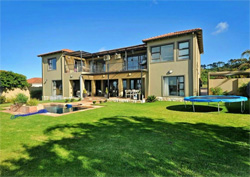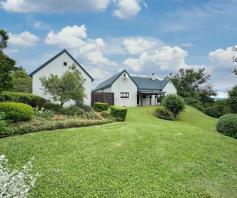Tough economic conditions and socio-political challenges have no doubt affected South Africa’s residential property market this year, with signs that it is losing momentum - but nevertheless the market has remained “extraordinarily resilient”, especially in certain pockets around the country.
 While national house price inflation is beginning to slow, Dr Golding says there are still several sectors within the local housing market which “continue to flourish and register positive real growth rates”.
While national house price inflation is beginning to slow, Dr Golding says there are still several sectors within the local housing market which “continue to flourish and register positive real growth rates”.Average South African house price inflation, according to the Pam Golding Residential Property Index, was 5.5% in 2015 and reached a cyclical high of 5.7% in March 2016, but now “appears to be slowing”, says Dr Golding.
This is at a time of rand weakening and escalating food prices which have driven the consumer price index above the Reserve Bank’s upper inflation target limit of 6%. “While the PGP Index has averaged 5.6% during the year to date, the consumer inflation rate has averaged 6.2% during the same period,” says Dr Golding. “This would suggest that, after adjusting for inflation, real South African house prices have fallen by an average of 0.6% compared to the same period last year.”
However, he says this “picture is misleading” since the national house price index is a weighted average of house prices across the country, reflecting a wide range of divergent performances evident in the different regions, metros, price bands and unit types.
So while national house price inflation is beginning to slow, Dr Golding says there are still several sectors within the local housing market which “continue to flourish and register positive real growth rates”.
Selling time - suburb matters most
 The Western Cape continues to buck the trend and remains the top performing major metro housing market in SA. This home in Clifton Cape Town is on the market for R85 million - click here to view.
The Western Cape continues to buck the trend and remains the top performing major metro housing market in SA. This home in Clifton Cape Town is on the market for R85 million - click here to view.So while the Western Cape has seen the highest overall growth in homeowners due to the semigration trend, from an activity perspective, Garsfontein in Pretoria is at the top of the list, with homes selling within 2.8 months of listing, he says. In contrast, a property in Parkhurst in Johannesburg remains on the market for an average of 7.4 months.
Growing demand from first-time buyers
Bond originator, ooba’s stats indicate first-time buyers, whose average age is 34 years old, accounted for 53% of all their home loan applications in the third quarter - and with SA’s young population profile, Dr Golding says demand from the growing number of first-time buyers will “continue to provide a positive fundamental underpinning for the South African housing market for the foreseeable future”.
It is also robust first-time buyer demand that helps to explain the continued strong price performance of the lower under-R1 million price band in all three major regional markets, he says.
First-time buyer demand is a key driver in the transformation of SA’s housing market, with 61% of all ooba’s applications in the third quarter of this year from black home buyers, and the figure at 73% for first-time buying, Dr Golding notes.
Western Cape property continues to tick up
 House price inflation in Gauteng underperformed the national index in recent years, but despite this Dr Golding says it is still SA’s economic powerhouse and home to half of the country’s high-net-worth individuals. This cluster home in Sandton is on the market for R8.5 million - click here to view.
House price inflation in Gauteng underperformed the national index in recent years, but despite this Dr Golding says it is still SA’s economic powerhouse and home to half of the country’s high-net-worth individuals. This cluster home in Sandton is on the market for R8.5 million - click here to view.Over the past nine months, the picture has generally remained unchanged. The Western Cape property market is still outperforming Gauteng and KwaZulu-Natal, which began in mid-2013, and more or less “coincides with the start of the semigration of buyers to the Cape”.
He says it is showing “no signs of slowing down” and there is still real growth in the Western Cape property market, with a significant number of buyers relocating to the province choosing to settle in the greater Cape Town area.
House price inflation in the Cape Metro averaged 11.9% during the first half of 2016, which was almost 5% ahead of Durban, the second-strongest metro market.
“Cape Town remains a niche property market, robust despite economic pressures,” says Dr Golding, and with investment in new projects of R16 billion anticipated during the next few years, the demand for high-end properties remains strong and above average house price inflation is likely to prevail.
Gauteng lags but still the economic heart of SA
House price inflation in Gauteng underperformed the national index in recent years, but despite this Dr Golding says it is still SA’s economic powerhouse and home to half of the country’s high-net-worth individuals. According to a recent New World Wealth report, Gauteng is home to half of SA’s 40 400 ultra-wealthy US dollar millionaires.
Dr Golding says Gauteng also attracts the majority of SA’s first-time buyers, many of whom move for career opportunities.
 Demand is particularly high along the northern KZN coastline, with a strong preference for homes in secure estates, and Umhlanga remains a hotspot. This house for sale in Umhlanga is on the market for R18 million - click here here to view.
Demand is particularly high along the northern KZN coastline, with a strong preference for homes in secure estates, and Umhlanga remains a hotspot. This house for sale in Umhlanga is on the market for R18 million - click here here to view.Several major infrastructural, commercial and residential developments are on the go in growth nodes such as Fourways, Midrand and Menlyn in Pretoria East, while he says they continue to see high levels of investment and growth in Sandton.
Secure estates like Steyn City and Dainfern remain “resilient and popular”, with an increase in the number of renovations and rebuilds in some of the more established estates, while with its convenient airport access, Lanseria is experiencing significant land sales, says Dr Golding.
Although house price inflation in Pretoria has slowed in the past few months, there is also rapid development across Tshwane metro and “many residential areas retain highly active markets,” he says. Apartments and homes in townhouse complexes and estates are in high demand.
Menlyn is one of the fastest-growing areas in Gauteng and new high-rise apartment developments such as Menlyn Maine Towers and The Regency are “proving popular” and are rapidly being sold off-plan as investors are attracted by the ‘work-play’ urban lifestyle, he says.
The planned Gautrain extension will “spark new growth nodes” and have a significant effect on the property market in several suburbs, says Dr Golding, and companies will often pay a premium for premises near a Gautrain station.
Robust activity on KwaZulu-Natal’s North Coast
In contrast to the “cooling house price inflation” in both the Western Cape and Gauteng, KwaZulu-Natal (KZN) is experiencing a modest rebound, with growth in prices rallying from 5.4% in late-2015 to a level of 7.5% in September 2016, says Dr Golding. There is no sign as yet that the rebound in prices is losing momentum.
 Average house price inflation in Nelson Mandela Bay was 5.4% during the first half of 2016, making it the third highest performing metro in South Africa. This house for sale in Theescombe, Port Elizabeth, is on the market for R3.999 million - click here to view.
Average house price inflation in Nelson Mandela Bay was 5.4% during the first half of 2016, making it the third highest performing metro in South Africa. This house for sale in Theescombe, Port Elizabeth, is on the market for R3.999 million - click here to view.The new Sibaya precinct will offer retail and office components, as well as prime residential nodes that rest above the sea and forest, says Dr Golding.
The increase in economic activity at Dube TradePort has also “further fuelled interest from property investors”, with international travel bolstered this year by the addition of four new international airlines.
To extend the transport network with the TradePort, local authorities are planning a rapid rail system which will connect King Shaka with Durban, Pietermaritzburg and Richards Bay. “The increase in economic activity and improved employment opportunities generated by developments at King Shaka and Dube TradePort are undoubtedly contributing to the revival in the property market in the region,” says Dr Golding.
Eastern Cape attracts more inland buyers
House price inflation in the Eastern Cape is gaining momentum as massive infrastructural and property investments in the region bolster activity in the local housing market, he says.
According to the PGP index, average house price inflation in Nelson Mandela Bay was 5.4% during the first half of 2016, making it the third highest performing metro in South Africa.
“During the past five years, freehold properties have risen by an average of 22.1% in Port Elizabeth and 29.2% in East London,” he says. “The massive new wave of economic investment, coupled with a new local government, suggests that the Eastern Cape housing market will experience a renewed bout of growth in the months ahead.”
‘Good year’ despite economic challenges
Dr Golding says despite challenging economic trading conditions for the first 8 months (March to October) of 2016, PGP has had a “really good year” and achieved turnover of just over R13.5 billion, 2% ahead of the previous year, which puts the group on track to achieve in excess of R20 million for the financial year ending February 2017.
Foreign buyers remain a low percentage of total buying, at 2% in SA and 4% for PGP over the past 12 months.
The top selling price for a property sold by PGP this year was R180 million for a farm in Paarl, with a freestanding house sold for R74 million.
He says where homeowners in the past stayed in their property for an average of five years, this is now slightly longer at seven years, and sectional title properties continue to outperform freestanding homes. – Julia Hinton









